Hyundai Coupe 2005 Owner's Manual
Manufacturer: HYUNDAI, Model Year: 2005, Model line: Coupe, Model: Hyundai Coupe 2005Pages: 478, PDF Size: 13.44 MB
Page 181 of 478
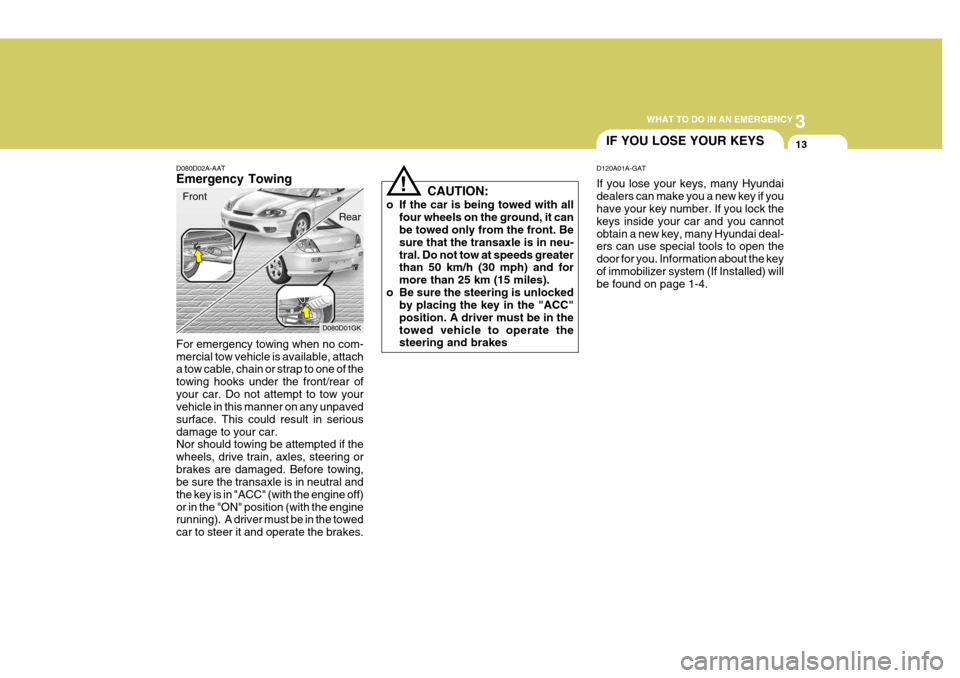
3
WHAT TO DO IN AN EMERGENCY
13
D080D01GK
!
D080D02A-AAT Emergency Towing For emergency towing when no com- mercial tow vehicle is available, attach a tow cable, chain or strap to one of the towing hooks under the front/rear ofyour car. Do not attempt to tow your vehicle in this manner on any unpaved surface. This could result in seriousdamage to your car. Nor should towing be attempted if the wheels, drive train, axles, steering orbrakes are damaged. Before towing, be sure the transaxle is in neutral and the key is in "ACC" (with the engine off)or in the "ON" position (with the engine running). A driver must be in the towed car to steer it and operate the brakes. CAUTION:
o If the car is being towed with all four wheels on the ground, it can be towed only from the front. Be sure that the transaxle is in neu-tral. Do not tow at speeds greater than 50 km/h (30 mph) and for more than 25 km (15 miles).
o Be sure the steering is unlocked by placing the key in the "ACC"position. A driver must be in thetowed vehicle to operate the steering and brakes
IF YOU LOSE YOUR KEYS
D120A01A-GAT If you lose your keys, many Hyundai dealers can make you a new key if you have your key number. If you lock the keys inside your car and you cannotobtain a new key, many Hyundai deal- ers can use special tools to open the door for you. Information about the keyof immobilizer system (If Installed) will be found on page 1-4.
Front
Rear
Page 182 of 478
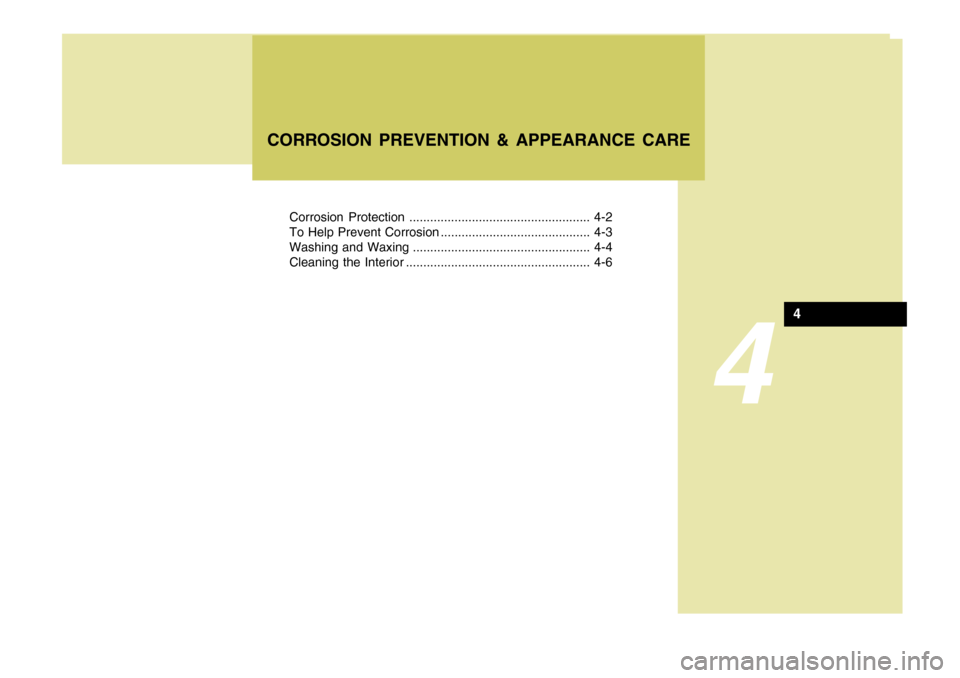
4
Corrosion Protection .................................................... 4-2
To Help Prevent Corrosion ........................................... 4-3
Washing and Waxing ................................................... 4-4
Cleaning the Interior ..................................................... 4-6
CORROSION PREVENTION & APPEARANCE CARE
4
Page 183 of 478
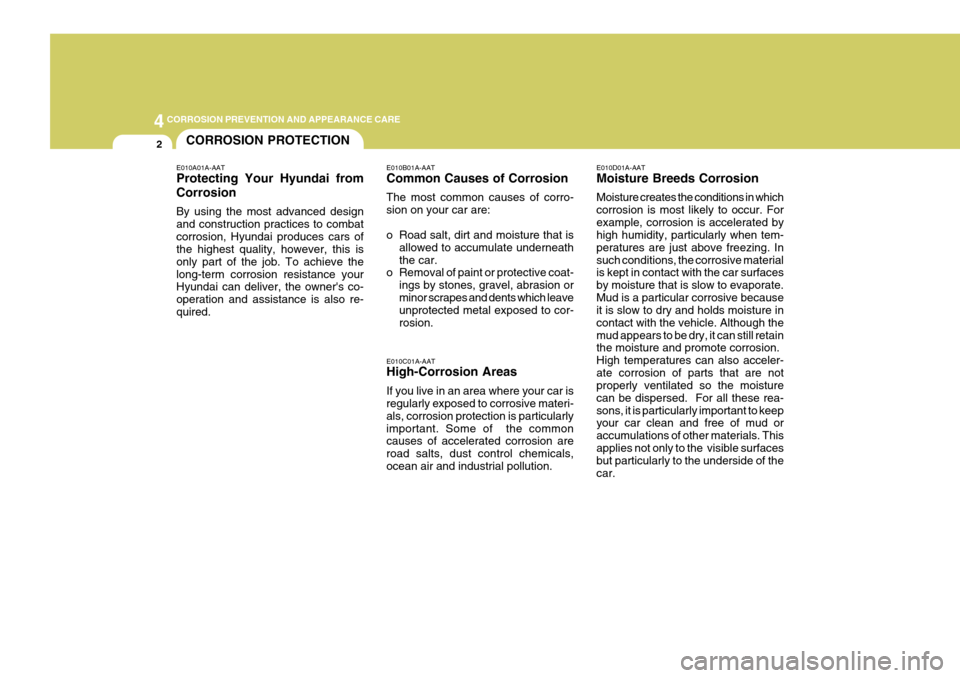
44CORROSION PREVENTION AND APPEARANCE CARE
2CORROSION PROTECTION
E010A01A-AAT Protecting Your Hyundai from Corrosion By using the most advanced design and construction practices to combatcorrosion, Hyundai produces cars of the highest quality, however, this is only part of the job. To achieve thelong-term corrosion resistance your Hyundai can deliver, the owner's co- operation and assistance is also re-quired. E010B01A-AAT Common Causes of Corrosion The most common causes of corro- sion on your car are:
o Road salt, dirt and moisture that is
allowed to accumulate underneath the car.
o Removal of paint or protective coat-
ings by stones, gravel, abrasion orminor scrapes and dents which leave unprotected metal exposed to cor- rosion.
E010C01A-AAT High-Corrosion Areas If you live in an area where your car is regularly exposed to corrosive materi- als, corrosion protection is particularlyimportant. Some of the common causes of accelerated corrosion are road salts, dust control chemicals,ocean air and industrial pollution. E010D01A-AAT Moisture Breeds Corrosion Moisture creates the conditions in which corrosion is most likely to occur. Forexample, corrosion is accelerated by high humidity, particularly when tem- peratures are just above freezing. Insuch conditions, the corrosive material is kept in contact with the car surfaces by moisture that is slow to evaporate.Mud is a particular corrosive because it is slow to dry and holds moisture in contact with the vehicle. Although themud appears to be dry, it can still retain the moisture and promote corrosion. High temperatures can also acceler-ate corrosion of parts that are not properly ventilated so the moisture can be dispersed. For all these rea-sons, it is particularly important to keep your car clean and free of mud or accumulations of other materials. Thisapplies not only to the visible surfaces but particularly to the underside of the car.
Page 184 of 478
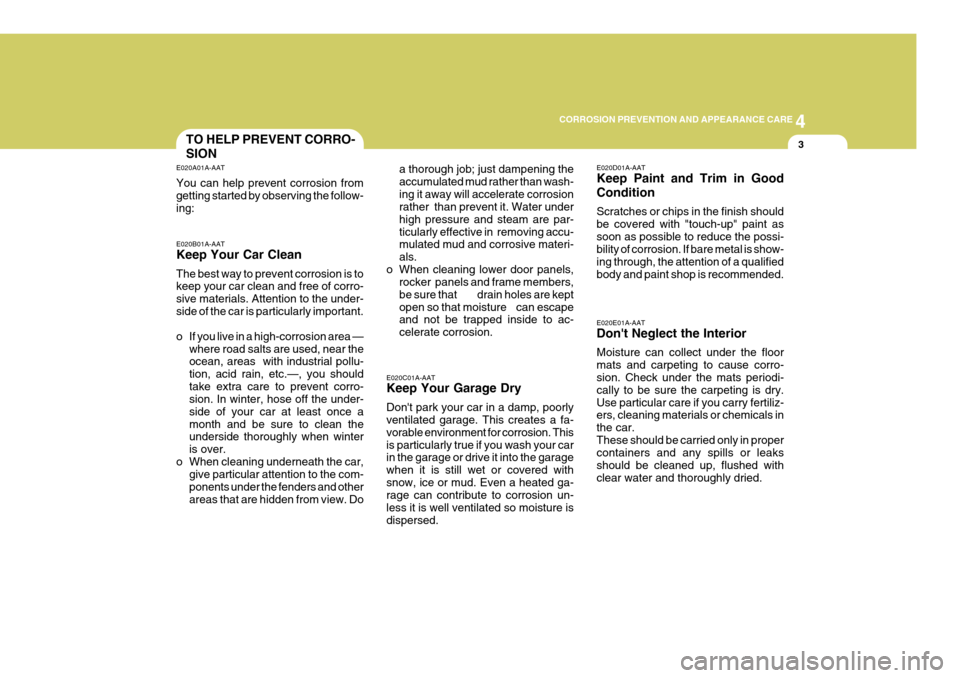
4
CORROSION PREVENTION AND APPEARANCE CARE
3
4
CORROSION PREVENTION AND APPEARANCE CARE
3TO HELP PREVENT CORRO- SION
E020A01A-AAT You can help prevent corrosion from getting started by observing the follow- ing: E020B01A-AAT Keep Your Car Clean The best way to prevent corrosion is to keep your car clean and free of corro- sive materials. Attention to the under-side of the car is particularly important.
o If you live in a high-corrosion area —
where road salts are used, near the ocean, areas with industrial pollu- tion, acid rain, etc.—, you shouldtake extra care to prevent corro- sion. In winter, hose off the under- side of your car at least once amonth and be sure to clean the underside thoroughly when winter is over.
o When cleaning underneath the car, give particular attention to the com-ponents under the fenders and otherareas that are hidden from view. Do E020C01A-AAT Keep Your Garage Dry Don't park your car in a damp, poorly ventilated garage. This creates a fa- vorable environment for corrosion. Thisis particularly true if you wash your car in the garage or drive it into the garage when it is still wet or covered withsnow, ice or mud. Even a heated ga- rage can contribute to corrosion un- less it is well ventilated so moisture isdispersed. E020D01A-AAT Keep Paint and Trim in Good Condition Scratches or chips in the finish should be covered with "touch-up" paint assoon as possible to reduce the possi- bility of corrosion. If bare metal is show- ing through, the attention of a qualifiedbody and paint shop is recommended.
a thorough job; just dampening theaccumulated mud rather than wash-ing it away will accelerate corrosion rather than prevent it. Water under high pressure and steam are par-ticularly effective in removing accu- mulated mud and corrosive materi- als.
o When cleaning lower door panels, rocker panels and frame members,be sure that drain holes are keptopen so that moisture can escape and not be trapped inside to ac- celerate corrosion. E020E01A-AAT Don't Neglect the Interior Moisture can collect under the floor mats and carpeting to cause corro- sion. Check under the mats periodi- cally to be sure the carpeting is dry.Use particular care if you carry fertiliz- ers, cleaning materials or chemicals in the car.These should be carried only in proper containers and any spills or leaks should be cleaned up, flushed withclear water and thoroughly dried.
Page 185 of 478
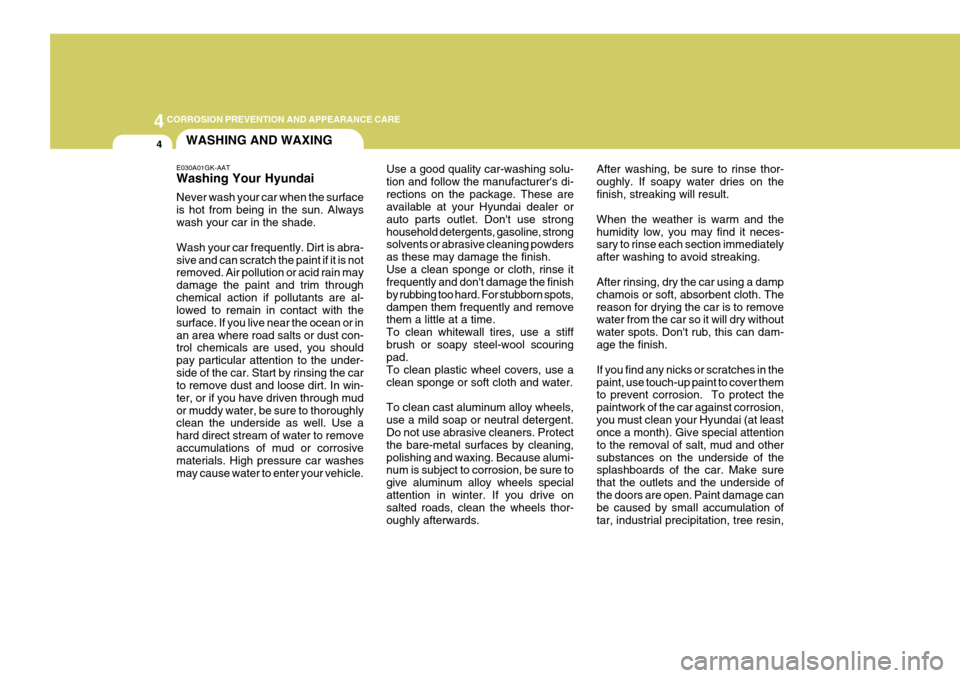
44CORROSION PREVENTION AND APPEARANCE CARE
4WASHING AND WAXING
E030A01GK-AAT Washing Your Hyundai Never wash your car when the surface is hot from being in the sun. Alwayswash your car in the shade. Wash your car frequently. Dirt is abra- sive and can scratch the paint if it is not removed. Air pollution or acid rain may damage the paint and trim throughchemical action if pollutants are al- lowed to remain in contact with the surface. If you live near the ocean or inan area where road salts or dust con- trol chemicals are used, you should pay particular attention to the under-side of the car. Start by rinsing the car to remove dust and loose dirt. In win- ter, or if you have driven through mudor muddy water, be sure to thoroughly clean the underside as well. Use a hard direct stream of water to removeaccumulations of mud or corrosive materials. High pressure car washes may cause water to enter your vehicle. Use a good quality car-washing solu-tion and follow the manufacturer's di-rections on the package. These are available at your Hyundai dealer or auto parts outlet. Don't use stronghousehold detergents, gasoline, strong solvents or abrasive cleaning powders as these may damage the finish.Use a clean sponge or cloth, rinse it frequently and don't damage the finish by rubbing too hard. For stubborn spots,dampen them frequently and remove them a little at a time. To clean whitewall tires, use a stiffbrush or soapy steel-wool scouring pad. To clean plastic wheel covers, use aclean sponge or soft cloth and water. To clean cast aluminum alloy wheels, use a mild soap or neutral detergent. Do not use abrasive cleaners. Protect the bare-metal surfaces by cleaning,polishing and waxing. Because alumi- num is subject to corrosion, be sure to give aluminum alloy wheels specialattention in winter. If you drive on salted roads, clean the wheels thor- oughly afterwards. After washing, be sure to rinse thor-oughly. If soapy water dries on thefinish, streaking will result. When the weather is warm and the humidity low, you may find it neces- sary to rinse each section immediately after washing to avoid streaking. After rinsing, dry the car using a damp chamois or soft, absorbent cloth. Thereason for drying the car is to remove water from the car so it will dry without water spots. Don't rub, this can dam-age the finish. If you find any nicks or scratches in the paint, use touch-up paint to cover them to prevent corrosion. To protect the paintwork of the car against corrosion,you must clean your Hyundai (at least once a month). Give special attention to the removal of salt, mud and othersubstances on the underside of the splashboards of the car. Make sure that the outlets and the underside ofthe doors are open. Paint damage can be caused by small accumulation of tar, industrial precipitation, tree resin,
Page 186 of 478
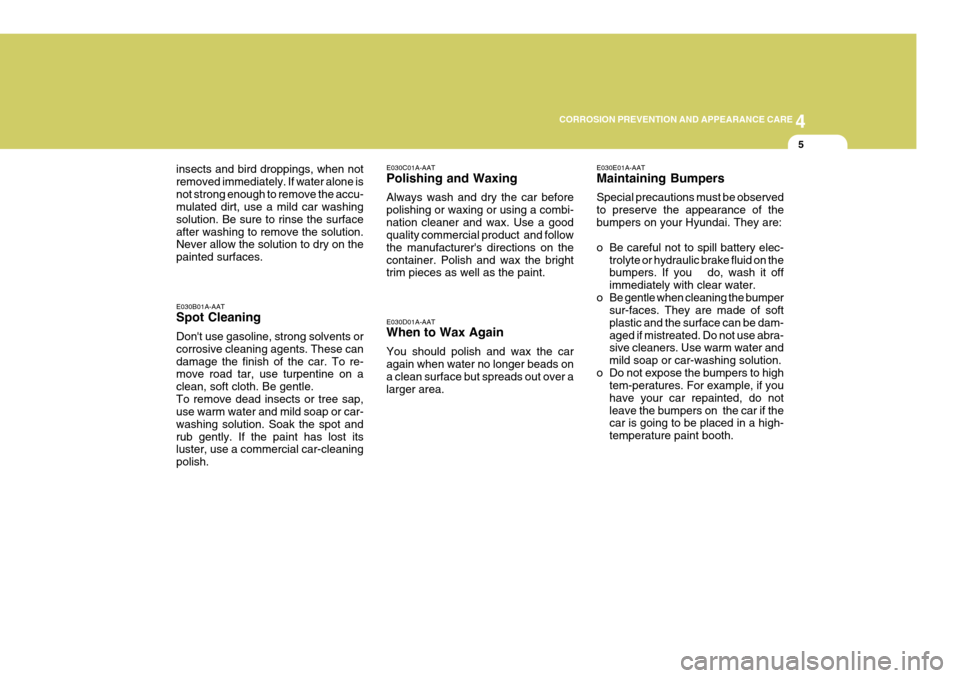
4
CORROSION PREVENTION AND APPEARANCE CARE
5
4
CORROSION PREVENTION AND APPEARANCE CARE
5
insects and bird droppings, when not removed immediately. If water alone isnot strong enough to remove the accu- mulated dirt, use a mild car washing solution. Be sure to rinse the surfaceafter washing to remove the solution. Never allow the solution to dry on the painted surfaces. E030B01A-AAT Spot Cleaning Don't use gasoline, strong solvents or corrosive cleaning agents. These candamage the finish of the car. To re- move road tar, use turpentine on a clean, soft cloth. Be gentle.To remove dead insects or tree sap, use warm water and mild soap or car- washing solution. Soak the spot andrub gently. If the paint has lost its luster, use a commercial car-cleaning polish. E030C01A-AAT Polishing and Waxing Always wash and dry the car before polishing or waxing or using a combi-nation cleaner and wax. Use a good quality commercial product and follow the manufacturer's directions on thecontainer. Polish and wax the bright trim pieces as well as the paint. E030D01A-AAT When to Wax Again You should polish and wax the car again when water no longer beads on a clean surface but spreads out over alarger area.
E030E01A-AAT Maintaining Bumpers Special precautions must be observed to preserve the appearance of thebumpers on your Hyundai. They are:
o Be careful not to spill battery elec-
trolyte or hydraulic brake fluid on the bumpers. If you do, wash it off immediately with clear water.
o Be gentle when cleaning the bumper sur-faces. They are made of softplastic and the surface can be dam-aged if mistreated. Do not use abra- sive cleaners. Use warm water and mild soap or car-washing solution.
o Do not expose the bumpers to high tem-peratures. For example, if youhave your car repainted, do notleave the bumpers on the car if the car is going to be placed in a high- temperature paint booth.
Page 187 of 478
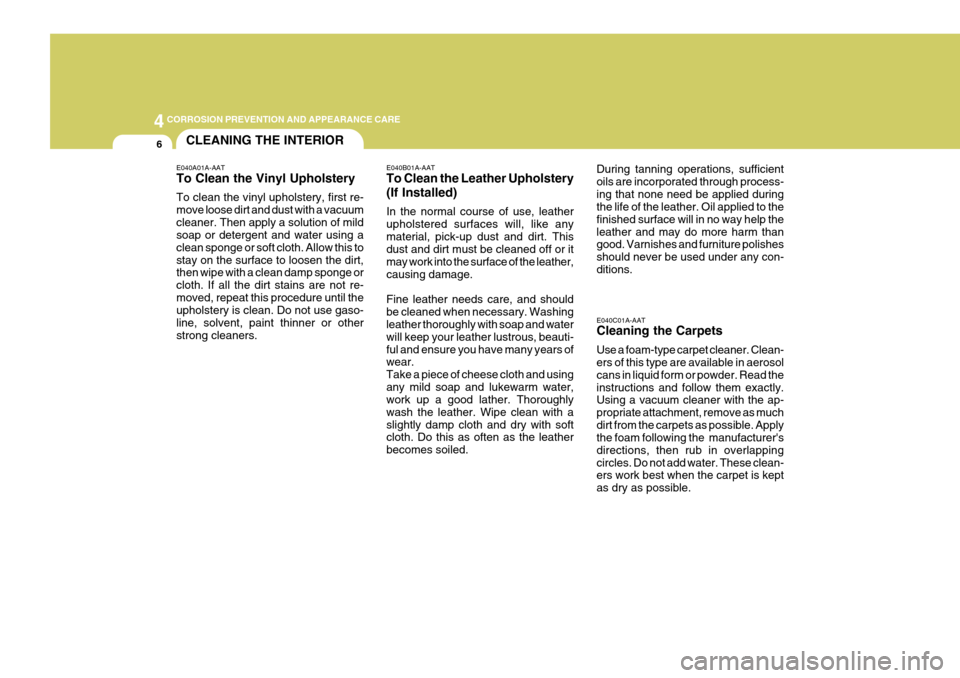
44CORROSION PREVENTION AND APPEARANCE CARE
6CLEANING THE INTERIOR
E040A01A-AAT To Clean the Vinyl Upholstery To clean the vinyl upholstery, first re- move loose dirt and dust with a vacuumcleaner. Then apply a solution of mild soap or detergent and water using a clean sponge or soft cloth. Allow this tostay on the surface to loosen the dirt, then wipe with a clean damp sponge or cloth. If all the dirt stains are not re-moved, repeat this procedure until the upholstery is clean. Do not use gaso- line, solvent, paint thinner or otherstrong cleaners. E040B01A-AAT To Clean the Leather Upholstery (If Installed) In the normal course of use, leather upholstered surfaces will, like anymaterial, pick-up dust and dirt. This dust and dirt must be cleaned off or it may work into the surface of the leather,causing damage. Fine leather needs care, and should be cleaned when necessary. Washing leather thoroughly with soap and water will keep your leather lustrous, beauti-ful and ensure you have many years of wear. Take a piece of cheese cloth and usingany mild soap and lukewarm water, work up a good lather. Thoroughly wash the leather. Wipe clean with aslightly damp cloth and dry with soft cloth. Do this as often as the leather becomes soiled.
E040C01A-AAT Cleaning the Carpets Use a foam-type carpet cleaner. Clean- ers of this type are available in aerosol cans in liquid form or powder. Read theinstructions and follow them exactly. Using a vacuum cleaner with the ap- propriate attachment, remove as muchdirt from the carpets as possible. Apply the foam following the manufacturer's directions, then rub in overlappingcircles. Do not add water. These clean- ers work best when the carpet is kept as dry as possible.
During tanning operations, sufficientoils are incorporated through process-ing that none need be applied during the life of the leather. Oil applied to the finished surface will in no way help theleather and may do more harm than good. Varnishes and furniture polishes should never be used under any con-ditions.
Page 188 of 478
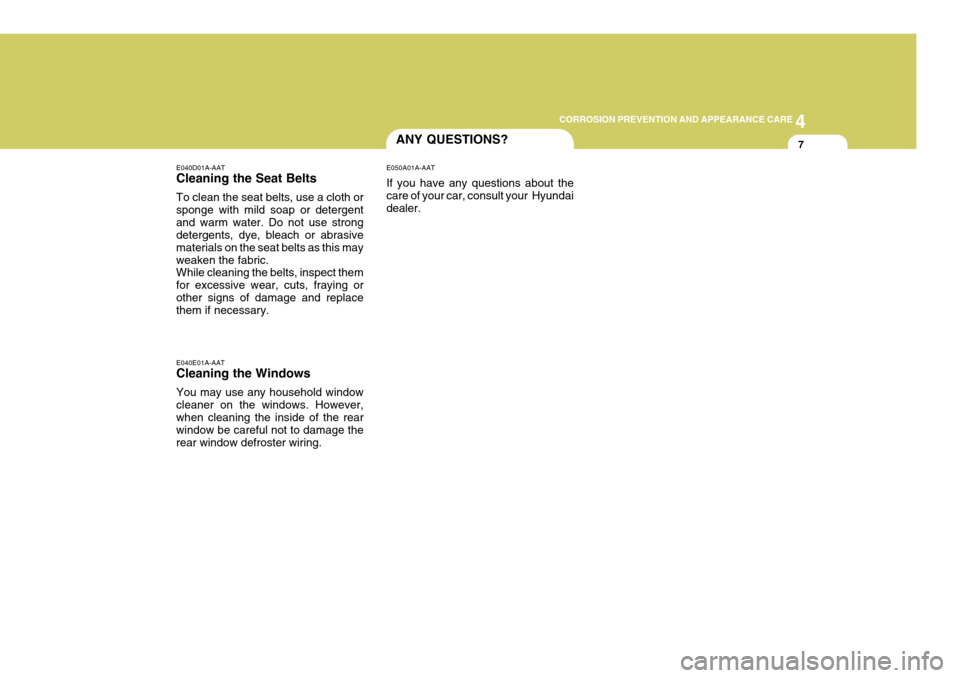
4
CORROSION PREVENTION AND APPEARANCE CARE
7
4
CORROSION PREVENTION AND APPEARANCE CARE
7ANY QUESTIONS?
E040D01A-AAT Cleaning the Seat Belts To clean the seat belts, use a cloth or sponge with mild soap or detergentand warm water. Do not use strong detergents, dye, bleach or abrasive materials on the seat belts as this mayweaken the fabric. While cleaning the belts, inspect them for excessive wear, cuts, fraying orother signs of damage and replace them if necessary. E040E01A-AAT Cleaning the Windows You may use any household window cleaner on the windows. However,when cleaning the inside of the rear window be careful not to damage the rear window defroster wiring. E050A01A-AAT If you have any questions about the care of your car, consult your Hyundai dealer.
Page 189 of 478
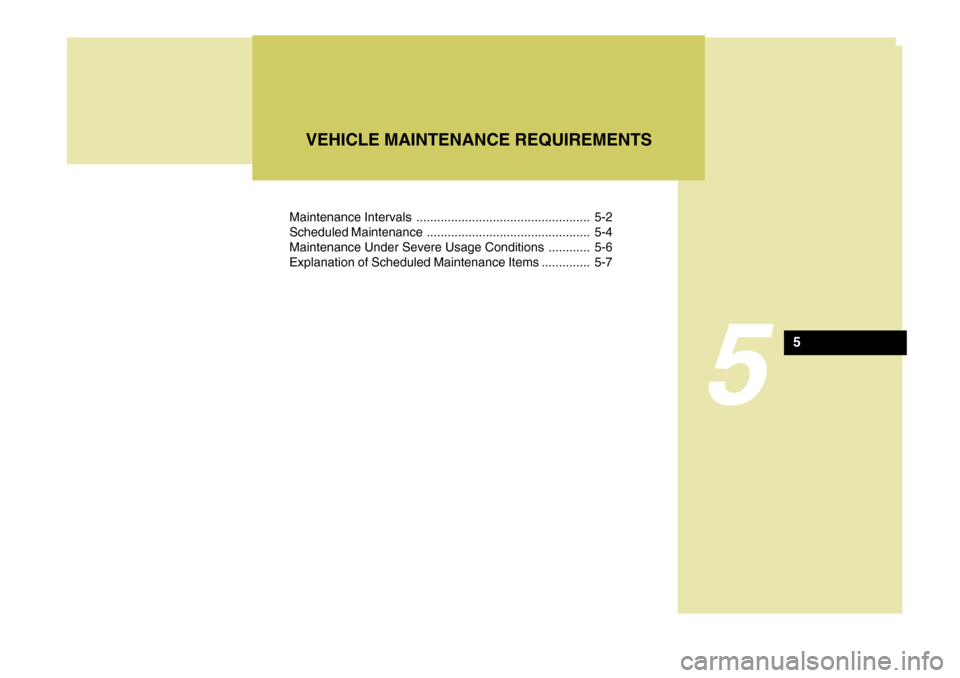
Maintenance Intervals .................................................. 5-2
Scheduled Maintenance ............................................... 5-4
Maintenance Under Severe Usage Conditions ............ 5-6
Explanation of Scheduled Maintenance Items .............. 5-7
5
VEHICLE MAINTENANCE REQUIREMENTS
5
Page 190 of 478
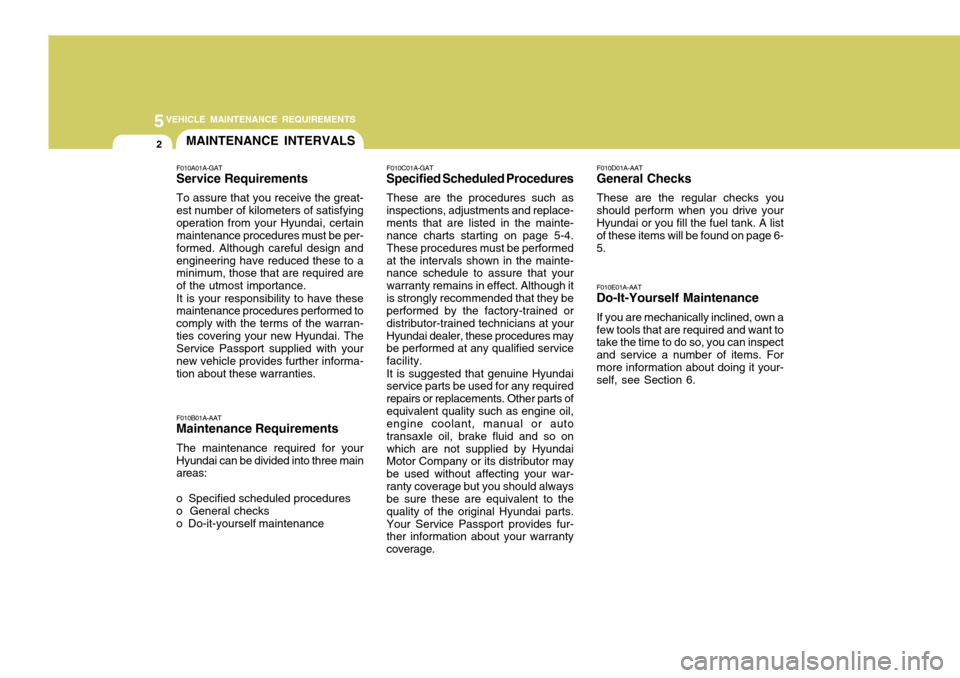
5VEHICLE MAINTENANCE REQUIREMENTS
2MAINTENANCE INTERVALS
F010A01A-GAT Service Requirements To assure that you receive the great- est number of kilometers of satisfyingoperation from your Hyundai, certain maintenance procedures must be per- formed. Although careful design andengineering have reduced these to a minimum, those that are required are of the utmost importance. It is your responsibility to have these maintenance procedures performed to comply with the terms of the warran-ties covering your new Hyundai. The Service Passport supplied with your new vehicle provides further informa-tion about these warranties. F010B01A-AAT
Maintenance Requirements
The maintenance required for your Hyundai can be divided into three main areas:
o Specified scheduled procedures o General checks o Do-it-yourself maintenance F010C01A-GAT
Specified Scheduled Procedures
These are the procedures such asinspections, adjustments and replace-ments that are listed in the mainte- nance charts starting on page 5-4. These procedures must be performedat the intervals shown in the mainte- nance schedule to assure that your warranty remains in effect. Although itis strongly recommended that they be performed by the factory-trained or distributor-trained technicians at yourHyundai dealer, these procedures may be performed at any qualified service facility. It is suggested that genuine Hyundai service parts be used for any required repairs or replacements. Other parts ofequivalent quality such as engine oil, engine coolant, manual or auto transaxle oil, brake fluid and so onwhich are not supplied by Hyundai Motor Company or its distributor may be used without affecting your war-ranty coverage but you should always be sure these are equivalent to the quality of the original Hyundai parts.Your Service Passport provides fur- ther information about your warranty coverage. F010D01A-AAT
General Checks
These are the regular checks you
should perform when you drive yourHyundai or you fill the fuel tank. A list of these items will be found on page 6- 5. F010E01A-AAT
Do-It-Yourself Maintenance
If you are mechanically inclined, own a few tools that are required and want to take the time to do so, you can inspect and service a number of items. Formore information about doing it your- self, see Section 6.